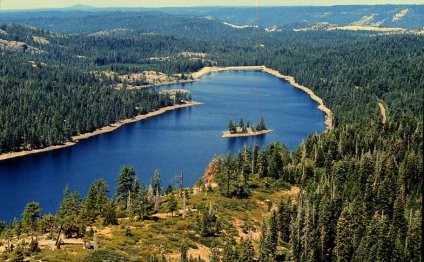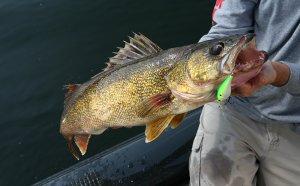
Lake Reservoir
Hidden Lake, Glacier National Park, Montana, is nestled in the high mountains, and runoff from the steep slopes of surrounding landscape helps to keep the lake full.
Credit: Lisa McKeon, USGS
View full size
If people had to pick their favorite water body, they might choose a crystal-clear lake nestled in the mountains (my opinion, or course!). Not all lakes are clear or are near mountains, though. The world is full of lakes of all types and sizes.
A lake really is just another component of Earth's surface water. A lake is where surface-water runoff (and maybe some groundwater seepage) have accumulated in a low spot, relative to the surrounding countryside. It's not that the water that forms lakes get trapped, but that the water entering a lake comes in faster than it can escape, either via outflow in a river, seepage into the ground, or by evaporation. And if humans live nearby, then water levels can be affected by water withdrawals for human needs.
A reservoir is the same thing as a lake in many peoples' minds. But, in fact, a reservoir is a manmade lake that is created when a dam is built on a river. River water backs up behind the dam creating a reservoir.
Here's a question for you: when a beaver dams a creek, is the pond that it creates a lake or a reservoir?
Lakes come in many varieties
The Earth has a tremendous variety of freshwater lakes, from fishing ponds to Lake Baikal in Siberia. Lake Baikal is the world's oldest, largest, and deepest freshwater lake. Nearly a mile deep and holding over 23, 000 cubic kilometers water, it would require the total volume of all the Great Lakes to fill it up if it were ever drained (NASA).
Most lakes contain fresh water, but some, especially those where water cannot escape via a river, can be classified as saline lakes. In fact, some lakes, such as the Great Salt Lake in Utah, are saltier than the oceans. Most lakes support a lot of aquatic life, but not all. The Dead Sea in the Middle East isn't called "Dead" for nothing —it is too salty for aquatic life! Lakes formed by the erosive force of ancient glaciers, such as the Great Lakes, can be thousands of feet deep. Some very large lakes may be only a few dozen feet deep—Lake Pontchartrain in Louisiana has a maximum depth of only about 15 feet.
Some of the salty lakes were formed in ancient times when they were connected to seas and when rainfall may have been heavier. These lakes have been shrinking since the last ice age. The ancient Lake Bonneville in the United States was once as big as Lake Michigan, and the Great Salt Lake was once about 14 times larger than it is now.
People use (and abuse) lakes
Greenlake Lake in Seattle, Washington. Urban lakes are highly valued by local residents for recreation (and for high property values of houses along the shoreline!).
Credit: Howard Perlman, USGS
Lakes are highly valued for their recreational, aesthetic, scenic, and water-supply qualities, and the water they contain is one of the most treasured of our natural resources. Lakes constitute important habitats and food resources for a diverse array of fish, aquatic life, and wildlife. But lake ecosystems are fragile. Lake ecosystems can undergo rapid environmental changes, often leading to significant declines in their aesthetic, recreational, and aquatic ecosystem functions. Exposed to external effects from the atmosphere, their watersheds, and groundwater, lakes are subject to change through time. Human activities can further accelerate the rates of change. If the causes of the changes are known, however, human intervention (lake-management practices) sometimes can control, or even reverse, detrimental changes.
Urban lakes, like this one in Seattle, Washington, are highly valued by local residents. Where urban lakes exist, you'll find lots of walkers and joggers, people enjoying canoeing and swimming, picnickers, and, of course, lots of dogs and ducks. The water can sometimes be used for water supply for a city's needs, also. Urban lakes do have special needs, though. Water quality must be monitored constantly; it would not be good for the mayor of a town to become ill from swimming in polluted water. The inflow of nutrients, such as phosphorus and nitrogen from fertilizers, must be restricted in order to prevent the overgrowth of algae. And, where there is wildlife, such as ducks, around, there is the chance of bacteria problems.
Characteristics of lakes
The following are some of the most important basic factors that give unique character to each lake ecosystem.
- Climate: Temperature, wind, precipitation, and solar radiation all critically affect the lake's hydrologic and chemical characteristics, and indirectly affect the composition of the biological community. Precipitation is the main factor affecting runoff and the delivery of nutrients and sediments.
- Atmospheric inputs: Precipitation, such as acid rain, and dry particles can be major sources of certain contaminants to a lake. Each lake also receives indirect atmospheric inputs by way of the runoff from its watershed.
- Underground rock and soils in the watershed: The soil type affects the potential for runoff and erosion. The physical characteristics of the underground rock determine the extent, nature, and quality of groundwater inflows and outflows.
- Physiography: The area, surface topography, existence of upstream lakes and wetlands, altitude, and land slope of the lake's watershed affect surface-water runoff and the amount and nature of chemicals and sediments entering the lake. Interactions with land use by people can greatly change how these factors affect runoff and the export of nutrients and sediment.
- Land use: The type, location, extent, and history of land cover/land use (such as agriculture, rural, and urban developed areas) can greatly affect the quantity of surface-water and groundwater inflows and outflows, as well as the amounts and types of sediment, nutrients and chemicals (natural or synthetic) that are transported into the lake from the watershed.
- Lake morphometry: Size, shape, and depth characteristics of a lake are critical in determining currents and mixing of the lake, as well as its thermal and chemical stratification characteristics.
Common environmental problems in lakes and probable causes
Share this Post
Related posts
What Kind of fishing is Walleye?
As a tournament walleye angler, one of the most frequently asked questions I get is about which rods to use in certain situations…
Read MoreWalleye fishing Reports Lake Erie
Staff Reporter Lake Erie fishing was good early this week, but rough conditions and heat held down the number of boats on…
Read More









